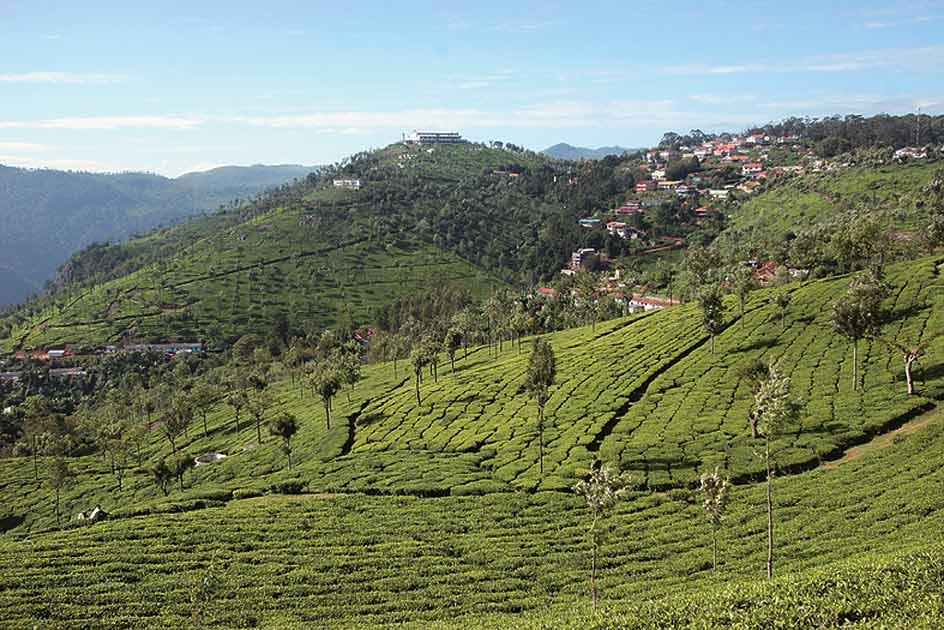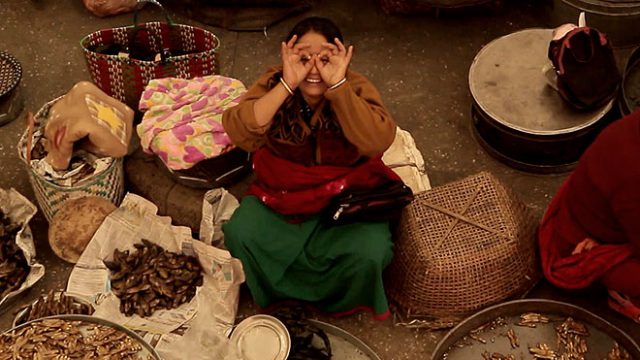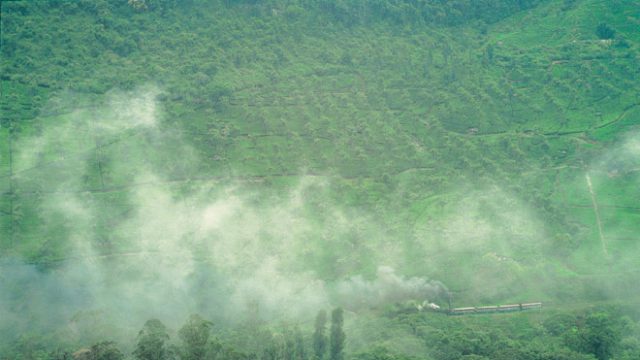S.X. Albert makes a living ceremoniously taking visitors around the High Field tea estate. The tea factory
Then we go inside the factory to where the plucked leaves lie in huge withering troughs with blow driers fitted beneath them, whirring air into the moist green layers to speed up the drying process. Now all the talk shifts to the importance of maintaining the right temperature and the many ‘cuttings’ or shreddings the leaves grow through. Albert commands us to peel bits of the velvety, warm moss off the conveyor belt and examine its texture. It is nothing like the grainy dark tea leaves one is used to seeing, but then tea ‘leaves’ are nothing like the green leaves from which tea is made. Albert lectures on about how, once the chlorophyll is removed from the shredded leaves, their ‘original’ colour returns. White tea is white because the tea plants are grown indoors in greenhouses. Green tea is made from tender buds, hence its colour.
Cut to the Tranquilitea Tea Lounge (no relation to High Field) where on a mantelpiece above a fireplace are laid out specimens of various speciality Nilgiri teas. The manager is talking about the exclusive Silver Tips tea made of unopened leaf buds plucked before daybreak and dried, naturally, in sunlight. We order cups of another rarity — handmade tea. To our chai-blunted taste buds the flavour is so subtle and fleeting it’s almost not there. Handmade tea tastes nothing like tea but then everyday tea is far removed from this world of tea as a connoisseur drink.
Coonoor, Ooty’s lesser-known sibling, is starting to come into its own. It is heartening to see a hill station offer more than just infrastructure for a quick weekend getaway. Sandeep Subramani, owner of the charming Tranquilitea and of tea estates in the area, is optimistic about Coonoor’s potential. The lounge, he says (which is housed in a 19th-century bungalow and on whose sunlit lawn you feel tempted, on a winter morning, to sit drinking cup after cup of delicately flavoured, exotically named brews), has been set up especially to showcase Nilgiri teas which are among the best in the world, but suffer from poor marketing. They have not yet become a recognised brand, says Subramani, unlike Darjeeling tea of which more is available in the market than is actually produced — other teas including ones from the Nilgiris are sold in its name!
Subramani is of the Badaga community which migrated south after the fall of the Vijayanagar empire in the 17th century. The Badagas speak a dialect of Kannada, yet have distinctive food and dress habits. When asked if any restaurant in Coonoor offers their cuisine he says to wait till January when Tranquilitea will serve authentic Badaga meals.
Another impressive venture is the Keystone Foundation, whose mission is to preserve the eco-system of the Nilgiris and create livelihood opportunities for its people. The foundation runs the Green Shop in Bedford in Upper Coonoor (with branches in Ooty and Kotagiri). They stock unusual stuff like bitter honey, beeswax candles and green pepper preserve, as well as products from organisations across the country that follow fair trade practices. The Ooty branch of the shop is combined with a honey and bee museum.
Cheese-making too has been something of a Nilgiris tradition. I also read in The Local — a chatty broadsheet that carries the district’s news — that organic farming is on the rise in the region. Marrying these two interests is the Acres Wild organic farm in Tiger Hill. The couple who run it makes a range of excellent and rare cheeses like Colby and Gruyère that are available through outlets in the town such as the Nilgiris shop in Bedford.
If you take the toy train up from Mettupalayam, Coonoor is the one major stop before Ooty. At the Coonoor station the steam engine is replaced by a diesel one, so, for aficionados of the mountain train, this is a good reason to go no further. Coonoor is also the point up to where the original railway line was built in 1899, which was later extended to Ooty.
Taking the Nilgiri Mountain Railway up is essential for the full Coonoor experience: the slowness of the journey prepares you for the town’s laidback ambience. The century-old railway is as much a colonial vestige as the hill station, reinforced today by its status as a Unesco World Heritage Site (along with the Darjeeling and Kalka hill trains). It takes an unbelievable three-and-a-half hour to cover the 19km distance between Mettupalayam and Coonoor, though in that short distance one ascends from a paltry 326m to Coonoor’s 1,800m. Doing the NMR has no connection whatsoever with functional train journeys — it is a slow-motion, toy-sized version of a train journey against movie-set backdrops and climbs across bridges strung at daredevil altitudes. It provokes nostalgia for something indefinable — perhaps the 19th century, perhaps old blues songs with steam engines in them, perhaps the bygone rituals of train travel, such as getting off every few kilometres at quaintly-named stations like Hill Grove and Runnymede to watch sooty men rake ashes out of the engine’s belly and direct hoses into the water compartments
For those expecting a pristine version of Ooty, though, downtown Coonoor with its cheek-by-jowl construction and chaotic traffic can be a bit of a shock. The colonial stamp becomes obvious as one goes up to the tea estates and to the many cottages and bungalows which dot the town’s upper reaches. Some of these are now hotels such as the charming, Neemrana-run Wallwood Garden that overlooks the fruit trees of the Pomological Institute, and the Taj Garden Retreat which was once Hampton Manor and is now, with its luxurious lawns, living up to the ‘garden’ in its name. These buildings can come with interesting histories — Hampton was a priory (the All Saints Church is next door), a hotel and then a private residence before being bought up on an impulse by a certain Australian serviceman called Cameron who was ‘a law unto himself’. Wallwood was once known as Blair Athol after the village from which the Scottish major who built it came. It was converted into a boarding school after the First World War. The 165-year-old YWCA building is another landmark, gifted by an anonymous Englishman to the association; its serene, old world air contrasts starkly with the concrete jungle of downtown Coonoor which it overlooks.
Also colonial in its antecedents is Sim’s Park, which is probably unique as botanical gardens in India go, both for the variety of its fauna and for the way it is landscaped — laid out in terraces in a steep ravine, with the immensity of trees that line the winding paths always hiding the true dimensions of the place. J.D. Sim, member of the governor-general’s council who built the park in 1874, appears to have been something of a tree collector. Sim’s Park is like a botanical zoo — it has over a thousand species of plants brought in from all over the world, some with exotic names like Monkey’s Puzzle and Leather Jacket and some with their provenance implied like Bhutan Cypress and Norfolk Island Pine.
Walking in Sim’s Park, making the slow ascent down to the small lake at the bed of the ravine, marvelling in the seeming ancientness of those 19th- and early 20th-century trees, is among the best things one can do in Coonoor. On a clear day there are also the viewpoints of Lamb’s Rock from where you can see the Coimbatore plains, and Dolphin’s Nose, as well as Droog Fort, accessed by a three-kilometre trek, and once used by Tipu Sultan as an outpost.
At the start of my journey, on the video bus from Coimbatore to Mettupalayam I am riveted by a Tamil film whose songs draw on the most outlandish sexual metaphors. The refrain of one goes — “My native place is Ooty, make me your sweater…” Good for Ooty but I’m fervently hoping Coonoor does not ever capture the imagination of Tamil film lyricists!
The information
Getting there: The nicest but slowest way is to get to Coimbatore), take a bus (Rs 10) or taxi (Rs 700) to Mettupalayam (34km/1hr) and then take the mountain train up to Coonoor (19km, FC Rs 127, 2A Rs 21). Taxis from Coimbatore to Coonoor will cost Rs 1,200 and from Mettupalayam to Coonoor Rs 700. The 7.10am train from Mettupalayam reaches at 10.40am; between March and May a second train runs at 10am. There is a return train from Coonoor at 1.30pm and an additional seasonal one at 3pm. Book in advance; the train tends to fill up even during the off-season.
Where to stay: Focus on options in Upper Coonoor; downtown can make you feel you never left urban ghastliness behind. The grandest is the Taj Garden Retreat (0423-2230021, www.tajhotels.com) whose cottage rooms, lush lawns and wood-panelled bar will make venturing out into the town feel superfluous. Rates are Rs 3,350 to Rs 5,750 and can go up to Rs 9,000 plus taxes for a double room during the season. Neemrana’s Wallwood Garden www.neemranahotels.com is excellent value for money — a lovingly maintained bungalow with cosy rooms in a pin-drop quiet location, and meals that have a home-cooked feel to them (Rs 1,750-2,500 plus taxes). Sandeep Subramani who runs Tranquilitea offers home-stays in one- and two-bedroom bungalows in Upper Coonoor (Rs 2,500/Rs 3,500 for one-/two-bedroom cottage; 9443841572, www.nilgirileisureholidays.blogspot.com). The YWCA (2234426) is the town’s best budget option (if you’re comfortable with the 9.30pm curfew and the no-liquor policy). It has spacious double rooms for Rs 400 and singles for Rs 200. More pricey and less charming is the neighbouring Velan (2230784, www.velanhotels.com) where doubles cost Rs 1,300-1,600. Cheaper and better is the Barrier Inn (Rs 500-1,000; 2232561) on Club Road with clean rooms and good views.
Where to eat: Coonoor is not exactly gourmet country, but with a little poking around you can get decent fare. The multi-cuisine Quality restaurant in Bedford also has a Kerala menu and they can rustle up a deadly mussels and appams combo. Also in Bedford, Dragon makes decent Chinese as well as vegetarian South Indian thalis. A new trend is the ‘bhojanalaya’. Mahalakshmi Bhojanalaya ambitiously offers meals ranging in ethnicity from Bengali and Marwari to Jain and Punjabi. Velan has a justifiable reputation for its steaks. Hotel Blue Hills offers more robust fare under the same ‘multi-cuisine’ rubric. In town, there are any number of places offering standard South Indian meals such as Laxmi Vilas Hotel.
What to see & do: Once you’ve done Sim’s Park and visited the viewpoints of Lamb’s Rock (8km), Dolphin’s Nose (10km) and Droog Fort, try the High Field tea estate which is 1km from Sim’s Park. Follow that up with a visit to Tranquilitea Tea Lounge (www.tranquilitea.in) on the Kotagiri Road.
Darjeeling of the Nilgiris
Nilgiri Mountain Railway
Leave a Reply
You must be logged in to post a comment.





